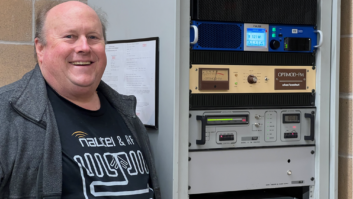Recent developments have renewed interest in RDS support among broadcasters. I’ve worked with countless engineers, general managers and program directors when implementing RDS and would like to share some of my knowledge to help you understand how the technology works and how to optimize it for your station(s). That’s the goal of this new series of articles, which as we go along will be posted online in one place to create a new RDS resource at www.radioworld.com.
The European Broadcasting Union designed the Radio Data System in the 1980s to provide information, such as the station name and what’s currently airing, to FM radio displays. This standard was improved over the years and later adopted within the United States in 1992, with slight modifications, by the National Radio Systems Committee. This variation from the European version is called Radio Broadcast Data System, or RBDS. Because the concepts I am discussing often are interchangeable between the European and American standards, I will refer to these standards collectively as RDS.

‘MyGig Navigation Radio’ is an optional feature included on many of the higher-end Chrysler models. Shown is model RER, included in a 2008 Jeep Grand Cherokee Limited. Earlier in this decade, major U.S. automobile manufacturers started including RDS on many factory-installed radios. In the past few years, automakers have improved on these early designs with newer radios that include multi-colored, larger display touch screens for configuration, GPS navigation and even viewing of DVDs or other videos. Luckily, they’ve been able to improve the RDS experience as well.
Within the past six months, the Insignia NS-HD001, Microsoft Zune HD and Apple’s iPod fifth-generation Nano, portable receivers with RDS support have entered the marketplace. The NRSC also has revived its RDBS subcommittee, as stations express a renewed interest in RDS.
With this series of articles, we’ll try to provide “best practices.” They might vary depending on your implementation, experiences and opinions, so please don’t consider them as things you “have to do,” but take them as suggestions. Please give me your feedback as we go along at [email protected].
The RDS/RBDS standard documents are lengthy, technical documents that are not easy to read. Luckily for us, we don’t need to know many of these details because RDS hardware/software vendors created products that handle most of the details already.
However, there are some basic things to know. The standard has two fields that are arguably the “most visible” as far as the listener is concerned. These are the PS (Program Service) and RT (Radio Text).
PS (Program Service)
The PS is an eight-character field designed in the initial RDS/RBDS standards to describe the radio station and remain static.
Many early RDS receivers only showed this field prominently on the display, featuring no other information. Over time, the use of the PS has evolved into a dynamic “scrolling” or “framed” display. Against the intention of the original standards, most stations in the United States now frequently change the text of what is in the PS field. Instead of leaving the PS with a fixed value of the station name, stations started interleaving the station name and song artist and title, advertisements, promotional and other messages within the PS.
Because the field is limited eight characters, many of the messages stations want to display don’t fit in such a small space, so RDS hardware and software vendors have developed solutions to take a long string of text — such as “93Q The #1 Hit Music Station Fireflies Owl City” — and chop it into the PS eight characters at a time, with time delays, creating the scrolling effect.
Since many radios prominently display PS when a user tunes to the station, this practice ended up being the best way to get the majority of radios with RDS support to display a variety of messages.
This “evolution” of PS hasn’t come without controversy; many have argued that it violates the written RDS/RBDS standards. Others are concerned that changing the display of a mobile receiver can be distracting to a driver. My goal in describing this is not to renew the controversy but to inform you as to the current state of the PS. Simply, most stations in the United States are employing some sort of scrolling or framing technique.
RT (Radio Text)
RT is a 64-character field designed in the initial RDS/RBDS standards to be used as either a static or dynamic display.
For stations that don’t have their automation systems updating their RDS encoders, this often is a basic static message with the station name and a short promotional message. Stations that have employed hardware and/or software solutions to get their automation systems to interface with the Radio Text may make this field dynamic, with a combination of the station name, song title/artist, advertisement/promotional messages, etc.
The problem is that receiver support for RT varies widely. Some receivers never supported this field. Those that did didn’t prominently display the RT.
On many receivers that support RT, you have to press a button in order to access this field. Also, since older designs didn’t always display all 64 characters simultaneously, the user often had to press the button several times to see the display, or the receiver itself would “scroll” the data across the display.
Luckily, newer automotive and portable players are starting to support the natural display of the RT, all the time, without additional intervention from the user. As receiver designs have improved and used higher-quality displays, they now have the ability to display most if not all of the RT all the time to the user.
Confusion between PS and RT
Because PS and RT are different fields in the RDS standards, they are treated differently by each receiver. I can’t tell you how many times I’ve talked to someone in the radio industry who gets these two fields confused. Often, this confusion involves the receiver the person is using.
Take the Denon TU-1500RD, a popular tuner used to monitor RDS data. The LED display doesn’t support a full 64 characters, so the receiver scrolls the RT on the display to make it fit. Many people confuse this with the PS scrolling or framing.
While the general listening public doesn’t necessarily need to know what they’re looking at (PS or RT), we in radio need to pay attention and understand how both fields relate to the user experience. I encourage you to try a variety of RDS-enabled radios to understand the user experiences listeners have.
It’s important to know that there are newer radios that support RT equally as well as, if not better than, PS. While so much emphasis in the industry has been on the PS and its scrolling/framing effects, we need to be equally as aware of the RT. Ignoring the RT is ignoring the user experience for listeners on newer devices. This is the future of radio displays.
The photo shows one of the newer installed automotive receivers on the market, made by Chrysler. This device, the “MyGig Navigation Radio,” is an optional feature included on many of the higher-end Chrysler models.
The company has several versions of this concept. Shown is model RER, included in a 2008 Jeep Grand Cherokee Limited.
Notice the huge open space on the right side where the RT is displayed prominently. Once you’ve tuned to the station, your eye immediately is drawn to this area of the screen. In fact, with a display like this, you ignore the PS, which is displayed in a less prominent area under the frequency. The PS in this figure is “93Q,” but this station uses a scrolling/framing PS display; over time the PS will show the song title and artist, too.
However, it is much more listener-friendly to show the entire RT immediately. I predict we are going to see more receivers that display the RT in a prominent way. The industry needs to make sure we’re placing as much value on the RT as we have with the PS in the past.
I’ve come across stations that are doing PS scrolling/framing and aren’t doing RT at all. If your station is in this situation, you should consider adding RT support for the reasons I’ve mentioned.
Next time, I’ll discuss the RT Send Rate and Optimization.
Alan Jurison is a regional IT manager/broadcast engineer for Citadel Broadcasting in Syracuse, N.Y. He holds several SBE certifications, including CSRE, AMD, DRB and CBNT.












